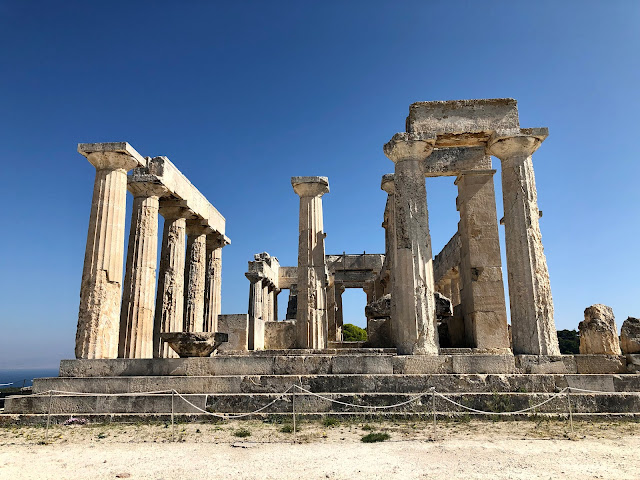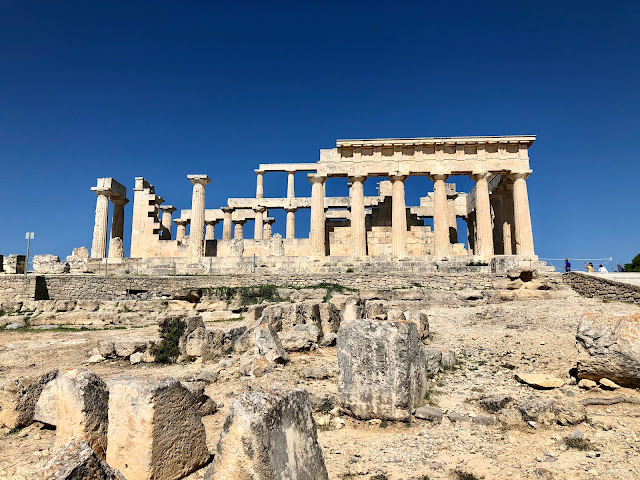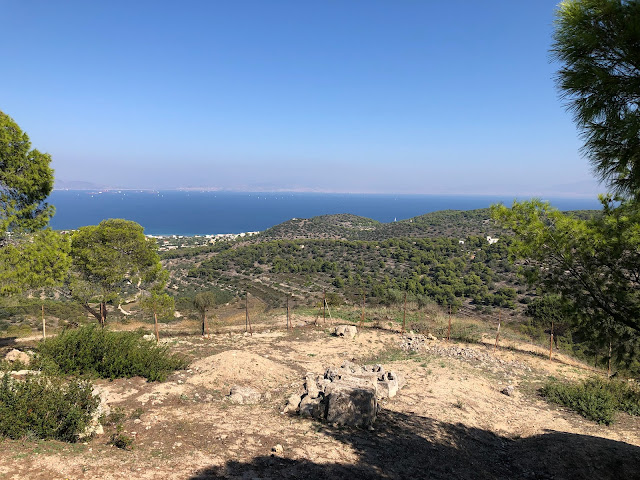I can imagine running a city is a tough job. The administration. The politics. The bureaucracy. Endless requests from constituents. Keeping everything operational. Making tough decisions that are instantly questioned by just about everyone. Where do rulers or mayors or governors or doges or kings or dictators or whomever is in charge of these places go for some good, sound advice? It must be really challenging.
I am sure these days that advice comes from everywhere and everyone whether it's sought after or unsolicited. Well maybe not for dictators, but everyone else probably. I'm guessing a bit on that one. But I do know that it didn't always work that way in Greece. And by Greece, I mean Ancient Greece. Like 2,500 years ago ancient. Maybe a bit more recently too. Like maybe 1,600 years or so ago.
If you were in charge of Athens or Naxos or Corinth or some other city-state back in the day (the day here being the roughly span of years cited above), there was a place you could turn to get some advice on whatever might be troubling you. Wondering when to plant crops? Or if you should start a war with a fellow city-state? Or maybe had some personnel dilemma going on in your life? Go to Delphi. Go see the Oracle.
Need a frame of reference here? Think The Matrix. Remember when Neo visited the Oracle and she told him he wasn't the One even though he turned out to actually be the One? Same deal. You wanted a prophecy or some advice in Ancient Greece then you visited the Oracle at Delphi. The Oracle, by the way, was the place, not the person. The person was a Pythia.
Now, if you decided to make the trip to Delphi, you'd have to do more than just show up and ask for some counsel. First, you'd need to sacrifice an animal. Go get yourself one of those and throw some cold water at it and see if it shivered. It did? GOOD! It's suitable for sacrifice, but maybe not completely good enough to get some of your questions answered. For that, the organs of the animal would need to get checked out by a priest. Cleared that hurdle? GREAT! Now you can ask some questions.
The questions answering though...not really a straightforward exercise. You wouldn't likely get a simple answer. It might be cryptic. It might be a series of words that could be arranged in different sequences to mean different things. It might seem to be completely useless. But what would you really expect from the Pythia, a woman who was inhaling methane or ethane or something else coming out of the ground that was addling her brain and making her barely coherent. Not kidding. That's the way the system worked. Remember the Oracle in The Matrix. Same deal. Well, except maybe without the gases but who knows really what went on before Neo knocked on the door.
Sounds like a crazy way to make important decisions, right? Is it any crazier than taking advice from the MyPillow guy? Think about that carefully before you answer.
Nobody really knows when the Oracle at Delphi was founded. There is a good amount of certainty that the place was around and fully functional in the 8th century B.C.E. but some feel it was founded a full 600 or 700 years earlier than that. But whenever it was actually established and like most things Ancient Greek, there's an origin story or myth that explains the whole thing. And of course, it's totally believable. Totally.
Apparently, around about the time the sanctuary was founded (whenever that was) the god Apollo had an idea that it was about time he had a physical location for the center of his cult. Good idea, right? First step: lay out the foundations of a temple in Delphi. The only problem was he didn't have anybody to staff the place. So he hijacked a ship full of sailors from Crete by appearing to them as a dolphin at first and later (after a divine wind pushed their ship where Apollo needed it to be) revealing himself as a deity and ordering them to serve him. I guess that sort of thing worked for gods. Temple complex staffed! I guess the Pythia came a little bit later.
Totally believable, right?
The Oracle was shared by 12 different Greek city-states, which took turns maintaining the sanctuary in any particular year on an as-voted basis. I guess the original crew of sailors only lasted so long. Most, if not all, of the city-states that chipped in to maintain the place considered that location to be so important that they regarded it as the center of the world. There's a stone called the navel right at the bottom of the path which begins the ascent to the Temple of Apollo and marks the exact center spot. This place was a pretty big deal. As strange as it seems to think that officials from cities would travel to a temple to listen to the babbling of a drugged-up woman, it happened. Regularly and seriously.
I mean what I wrote in that last paragraph purely factually, by the way, with no judgement whatsoever. I mean it's not like she chose this path as a career, although I'm sure the idea of the position appeared to be prestigious, if not exactly that healthy. You know...the inhaling gas thing.
 |
| The cone-like thing in the foreground is the navel. |
The location, by the way, is stunning. It is built most of the way up Mount Parnassas in front of this wall of porous pink and grey jagged rock that serves as this magnificent backdrop to the approach to the Temple (and the Temple itself once you are behind the actual building). Look back the way you came down the hill and it seems like you can see mountains forever as you look out over the rest of the range that you climbed to get there. Pick your amazing view. There's definitely more than one choice at Delphi.
We made this climb in October of this year. But our climb was done in a bus. A very large bus traversing what seemed like impossibly small roads through mountains and here and there through the odd town where it seemed like the roads were even more impossibly small. It took us probably three hours to get there from Athens, which I imagine is one of the closest ancient city-states to Delphi. In the centuries long past? No road and no bus. Horse, donkey or walk. Or sail and then horse, donkey or walk. The time to get there with those modes of transportation? Two days or so, depending on the weather. You can actually see the port from the Temple itself. It seems far away but our guide told us it takes about two hours to walk it.
If there was any sort of silver lining to walking or donkeying or sailing back in the old days, it was that you might not have had to bring your own sacrificial lamb (or other animal of choice). The first stop we made on our tour of the site at Delphi was at the remains of an old storefront where you could pick up an animal to sacrifice. Convenient, yes? And if you couldn't afford a sacrificial animal? Well, according to our guide, the shops also sold small animal figurines that served the same purpose. No word on how the organs were examined.
I know what you are thinking by the way. It's that this can't be real. Somehow the centuries have obscured what really happened at Delphi and have replaced the truth with some fabricated nonsense. But apparently, it's true. The whole thing was documented by the historian and writer, Plutarch, who also happened to be a priest at Delphi. If I were a skeptical person, I'd wonder if he made it sound more fantastical that it really was but for the purposes of this post, I'm going with Plutarch. I don't really have much other choice.
 |
| The remains of the old Roman Stoa, where back in the day you could pick up an animal for slaughter. |
That last nugget is a theory, but there is other evidence that suggests it might be true. And it's not my theory.
The ritual was more strange than I've made it sound by the way. The full story we got on our tour involved not only inhaling of gases and speaking words in random order that had to be examined after the fact to find out what they really meant but there were beans (for reading) and laurel leaves (for chewing) involved. I mean this was a full-on, chemical-induced bender. No other word for it. And people and officials of cities paid for the privilege of an audience.
Eventually, maybe the money got to be too much to hold readings or audiences just once per year. Demand was up and so the schedule moved from once a year to once a month, to coincide with Apollo's birthday, which was on or about the 7th of some month. Then sessions became perhaps even more frequently than that. So what happened to the poor woman who needed time to recover? Well, they diversified their workforce and expanded their staff. What else would they do? They added Pythia to keep up with demand and not kill their most valuable publicly-facing asset. Although maybe it wasn't enough to keep them all upright and breathing. More speculation there.
Well, that sort of thing was possible. And of course, it involved more money. Or more precisely, the giving of high profile gifts, or maybe (if you were really enterprising) the establishment of a treasury right on site funded by your city-state. Think of it as a frequent flyer benefit. Or a Fast Pass, for you Disney aficionados. Needed to get to the front of the line and get those beans read? Make sure you give a lot. Or keep a stash right on site. Money talks. Hopefully that's not a surprise.
So what did the sanctuary do with all these gifts? Well, they built. A lot. There is a model of the entire site at its height in the nearby Delphi Archaeological Museum and the place is huge. For its location, the main Temple of Apollo is gigantic, with thick Doric columns six across on the front and back and 15 deep at the sides. It's also spectacularly located about halfway up the last part of the mountain, with its long side the focus of a procession that must have been awe-inspiring for the first-time visitor considering the lore of the place.
The Temple is not the only thing that the sanctuary built. Once you got to the part of the site where the Temple was located, you'd find other buildings to support the activities at the site including a full theater for performances. Take all that on top of the treasuries and sculptures and tributes that lined the path to the Temple and the place must have been impressive back in the day.
 |
| The Athenian treasury (top). Model of the site in the Museum (bottom). Note the treasuries in the model. |
Today most of what made up the Oracle complex is gone. All that's left of the Temple itself is the front six columns that formed the main entrance. Other buildings at the site are largely less complete than the Temple, although the theater is still more visible than that since those kinds of structures in ancient Greece were usually built into the side of a hill. The most intact structure is the treasury erected by Athens, which is standing pretty much complete on the path up to the Temple. Or complete as we think of Greek temples today, completely naked with no additional ornamentation other than the carving of the pieces of stone that make up the building.
Even with most of the buildings missing from the site, you can still get a really good sense of what the Temple must have been like at its height. I know I've said this in every other Greek temples post I've written (meaning two...) but the Greeks were really, really expert at siting a temple on a piece of land. The approach to the Temple of Apollo is masterful and it is obvious how powerful it could have been even with most of what used to be there long, long gone. You can tell from walking up to the Temple front today that the broad side and entrance of the Temple must have been teased and removed from view as you ascended to the plaza right in front of it which must have made that final reveal and arrival seem like a huge payoff. It happens today, just without the long side of the Temple being there. You can see the front all the way up the hill but just not very well until you actually arrive there.
The one thing you don't get from walking up to the Temple today is how big it actually was. Not even when you are standing in front of it do you understand its size. That missing long side really does hinder your ability to do that. But walk a little bit further up the hill and the true size is visible in the entirety of the excavated podium that that Temple sat upon. It's really impressive. That, for me, was the reveal at modern day Delphi that blew me away, especially set against the backdrop of the pink and grey wall and the mountains that went on forever. It is a stunning site.
 |
| What's left of the main entrance to the Temple of Apollo (top). View from above (bottom). |
































